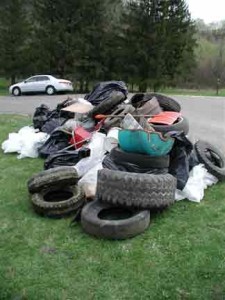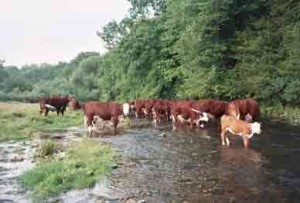Rush River
Prime fly fishing water close to the Twin Cities metro.The River
The Rush River is a tributary of the Mississippi River in western Wisconsin. It rises just north of Interstate 94 in St. Croix County, near Baldwin, and flows southwardly through Pierce County. It ends in Lake Pepin of the Mississippi River, about 1 mile west of the village of Maiden Rock in Pierce County. Limestone outcroppings and broad valleys provide a mix of scenery for this wide, fertile river that supports good fly hatches throughout the year.
The Rush averages about 2,500 trout per mile. Brown trout inhabit the river from the Centerville Springs to 3 miles south of Hwy 10. The Rush receives most of its water from surface run-off but the cooler temperatures have indicated some natural reproduction. With water quality increasing and temperatures decreasing, stocking of browns and brook trout has been eliminated.
The largest tributaries of the Rush are Lost Creek, and Cave Creek, which are small, but also excellent fisheries. Brook trout reproduce naturally in Lost Creek and Cave Creek, a main source of increasing brook trout populations that can be found on the Rush.
“The hatches are prolific and fly anglers can access the river at many spots along the way.”
The Rush River is a great trout fly fishing destination in Wisconsin. There are pools, riffles, and flat runs that hold plenty of insect life. The hatches are prolific and fly anglers can access the river at many spots along the way. It does not hold as many trout as the nearby Kinnickinnic River, but they are larger in size. This is because of the freestone nature of the stream, with slightly warmer water, which produces larger food sources for the trout
Due to it’s proximity to the Twin Cities metro area, the Rush River is one of the more popular and heavily fished streams in the state. Although it is an outstanding trout fishing destination, you won’t find solitude here.
The Resource Challenges
The Wisconsin DNR records show that Pierce County trout streams have improved substantially during the past 50 years. In 1980, Pierce County had 17 trout streams for a total of 97 miles. Currently, there are 47 trout streams for a total of 159 miles. Class I trout streams increased from 11 miles to 47.7 miles and Class II streams increased from 55 miles to 108 miles. Water quality and habitat are improving on most streams. However, certain stream segments suffer from high water temperatures, weak spring flow, poor habitat, flooding, bank erosion, and sedimentation and nonpoint pollution from runoff from agricultural and urban lands. Runoff from Pierce County watersheds also causes sedimentation and nitrification to Nuggett Lake and the Mississippi and St. Croix Rivers.
Agricultural Land
Agricultural land dominates the landscape in Pierce County with over ¾ of the land in agricultural use. Agriculture is changing in the county, however. Agriculture is the major land use affecting surface waters in this watershed. Trends are toward fewer dairy farms, more small and very large farms, and conversion of agricultural land to residential land. The comparison of current land use to original vegetation shows a significant conversion of prairie and forests to cropland and pasture. This land use conversion has led to a larger volume of runoff and less infiltration of precipitation. Much of St. Croix County and Pierce County shows very high possibility of ground water contamination due poor agricultural practices and urban development. The fractured limestone in this region (known as karst) which allows pollutants to leak into the aquifer that local residents drink from and provide source water for many rivers.
Run-off
The Rush is subject to pesticide and herbicide run-off, and to scouring by flash floods. The Rush River is normally a dry run in this area, but during spring runoff and heavy rain, runoff washes soil and animal waste down into the river. This causes silt and nutrients to be deposited into the trout stream. The storm runoff to Rush River tends to be high due to the tight clay soils responsible for reducing infiltration rates. The Rush River Watershed comprises 245 square miles in Pierce and St. Croix Counties.
The Pierce County portion of the Rush River Watershed is considered a Class II trout stream. To improve the Class II portion of the Rush River, the stream’s average temperature needs to be decreased. This can be accomplished by increasing the amount of groundwater discharging to the river. To improve groundwater discharge, best management practices should target increasing infiltration to replenish groundwater supplies. These measures would also reduce sedimentation and turbidity in the stream.
Feed Lots (known as CAFOs)
The factory-scale farms are relatively new to Wisconsin because strict water quality laws have discouraged them from coming here. In the past few years the state has provided planning grants and other incentives to stimulate economic development. This has provided the incentive for smaller farms to expand–but has also made factory farms possible.
Pollution from concentrated animal feeding operations (CAFOs) has become an issue of considerable concern to TU members throughout the country. Of particular concern to many members is the lack of legal controls and public input associated with the construction and management of these facilities.
In 1998, fisherman and local residents of Martell opposed feedlot operation that was close to Rush headwaters and within feet of the river. The facility would have contained 850 cows on 45 acres of land. Five million gallons of liquid manure were to be stored in clay lined lagoons/ponds called Manure Holding Facilities. This type of lagoon is legally allowed to leak a certain amount under the existing permit regulations. Even with the best technology and a concrete lining, there can be leakage. The strong opposition from local residents and conservation groups caused the feedlot to move elsewhere.
The Family Farm
Most family farms in this area use good conservation practices and are concerned about their neighbors and the environment. There have been several family farms that have received awards for their conservation work. Often large operations don’t have the time or money required to follow these practices. Please support your family farms by buying local when you can, respecting the land on which they live, and most of all remember to thank them when you have a chance. If these farms in our area give way to corporate farming practices, we may look back and wonder how the loss of this precious resource happened.
“Most family farms in the area use good conservation practices and are concerned about the environment.”
Stream Access
Meeting fishery resource demands, several streams including the Rush and Kinnickinnic Rivers have national, regional, and statewide significance as sport and/or trophy trout fisheries. Fishing pressure on popular streams reach saturation levels, and anglers are focusing their efforts on lesser-known streams in the area. As residential and private recreational land development increases along streams, public access is being lost. Trespass issues are on the increase on rivers such as the Rush and Trimbelle. Increased efforts are recommended to secure public parking and access to the best Pierce County trout fishing resources.
Recently, nine fishing easements have been purchased on the Rush River. Look for the DNR Streambank Fishing Easement or Rush River Fishing Path Initiative signs for access to private lands open to public fishing. In addition, several other large parcels have been purchased by West Wisconsin Land Trust and the U.S. Army Corps of Engineers, and the Koch Family Trust Lands donated to the Eau Galle/Rush River Rod & Gun Club. These are now open to public fishing. Look for the appropriate signage. For handicapped access check out the new facility on the Rush River just south of El Paso. Be sure to ask permission before crossing land to enter our streams, and make sure to say “thanks” to the folks that our allowing us on their property.

A recent clean-up garnered over 210 volunteers that gathered mountain of garbage–1,300 lbs. of trash, 1,280 lbs.of tires, 460 lbs. of recyclables and 440 lbs.of scrap metal–from the river.
Rush River Clean-up
Say thanks by helping with the Rush River Clean-up One way to say thanks, is to participate in the annual Rush River Clean-Up project, held every spring since 2003. Headed up each year by the project champion Sarah Sanford, the Eau Galle Rush River Sportsman’s Club (with plenty of TU manpower), and other volunteers from Minnesota and Wisconsin, will their annual pilgrimage to clean up cans, tires and other trash from the Rush River.
This is your chance to help clean-up effort helps keep the river pristine and enhances the relationship between anglers and land owners. Folks such as yourself, young and old, boys and girls, gather to take part in cleaning up the river for a day. It’s one small way to give back to landowners and the trout for all of the joy and pleasure we receive by being lucky enough to fish on this outstanding resource.
For more information on the river or fishing opportunities in the area also see:



